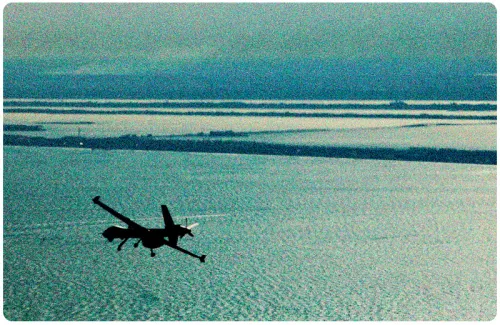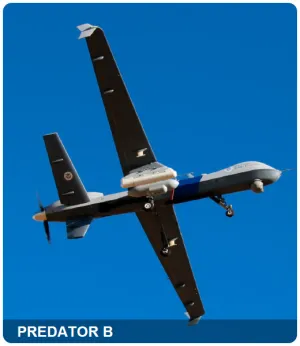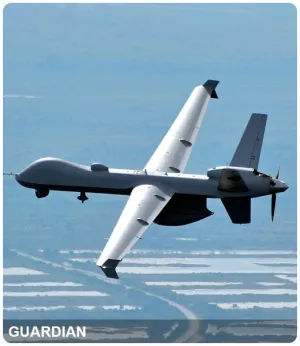U.S. Customs and Border Protection guards nearly 6,000 miles of land border and 95,000 miles of shoreline around the United States. In 2005, CBP began using the MQ-9 Predator B Unmanned Aircraft System (UAS) – marking a leap forward in the use of unmanned systems for CBP by further enhancing operational capabilities and increasing domain awareness. The UAS program focuses operations along four CBP mission areas, to include:
- Air, Maritime, and Land Law Enforcement
- Domain Awareness
- Extended Border and Foreign Operations
- Contingency and National Security Operations.
Air and Marine Operations (AMO) UAS is a critical element of CBP missions to predict, detect, identify, classify, track, deter, and interdict border traffic that threatens the continuity of U.S. border security. This is an integral capability used to safeguard our homeland through the coordinated application of aviation and maritime law enforcement resources within the air, sea, and land environments. This includes detecting, deterring, and interdicting illicit border crossings; conducting investigative activities; collecting intelligence; and performing reconnaissance patrols.
CBP requires air and maritime domain awareness to achieve air and maritime security. AMO UAS supports missions to continuously detect, monitor, and track potential threats in the land and maritime domains. The UAS contributes to greater situational awareness for U.S. Border Patrol (USBP), AMO Marine Units, as well as domestic and foreign partner agencies to enable the detection, identification, classification, and tracking of land and maritime incursions using a variety of capabilities.
AMO UAS supports CBP Extended Border and Foreign Operations missions, to include U.S. and foreign government partners. This mission area involves detecting, identifying, classifying, tracking, and interdicting illicit activities in the Source and Transit Zones while conducting combined and joint operations. These operations require partnership and collaboration with foreign governments and foreign law enforcement organizations.
AMO UAS also supports CBP Contingency and National Security Operations by providing aviation observation and other related air and marine capabilities as part of a whole-of-government approach to major and large-scale events. UAS provides critical information that enables CBP and its components to coordinate domestically and internationally with stakeholders for contingency operations such as disaster response. Contingency and national security operations include, but are not limited to, search and rescue operations, federal disaster relief, humanitarian relief, designated National Special Security Event, terror threat response, and partnering with non-law enforcement operations for training and exercises.
CBP first employed the Predator B to enhance law enforcement operations on the Southwest Border in 2005 and then along the Northern Border in 2009. AMO initially selected the Predator B for its unique combination of operational capabilities, payload capacity, mission flexibility, potential to accommodate new sensor packages, and its safety and performance record. The MQ-9 Predator B provides AMO with long range persistent surveillance capability and gives AMO the ability to provide high-quality streaming video to first responders, and to assess critical infrastructure before and after events; making it an ideal aircraft to aid in emergency preparations and disaster recovery operations.
AMO also operates an MQ-9 UAS maritime variant called the Guardian. Alongside the Predator B, AMO’s Guardian aircraft fly from three designated National Air Security Operations Centers (Grand Forks, North Dakota; Sierra Vista, Arizona; and San Angelo, Texas) and deploys outside the U. S. as mission requirements dictate. The Guardian has proven itself an invaluable asset in the Atlantic, Pacific, and Caribbean areas of operations.
In 2012, AMO added the Vehicle and Dismount Exploitation Radar (VADER), a sensor used in strategic and tactical operations that provides comprehensive situational awareness over wide border areas by detecting movement across the border. VADER-equipped UAS are an effective tool to help crews detect, classify, and track moving traffic over land. AMO also uses SeaVue maritime radar sensors on UAS which are effective for detecting, classifying, and tracking maritime surface traffic in coastal areas surrounding the U.S. and the maritime transit zone used by transnational criminal organizations to transport bulk quantities of illicit substances.
AMO has grown the MQ-9 program from 468 flight hours in fiscal year 2007 to 11,386 flight hours in fiscal year 2022. AMO UAS crews reported 104,755 detections of cross-border and maritime traffic suspected of illegal activity during fiscal year 2022. Additionally, missions conducted by AMO UAS crews led to the seizure of 9,189 pounds of marijuana and 28,934 pounds of cocaine. For the past 18 years AMO has been a leader in the effort to fully integrate remotely piloted systems into the national airspace system.






